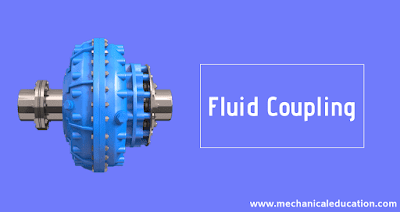Fluid Coupling:
Fluid Coupling: Fluid Coupling is also known as hydraulic coupling, In this article we will discuss about fluid coupling, main parts of fluid coupling, principle, working of fluid coupling.A fluid coupling is a mechanical device which used for transmitting the rotational power from one shaft to another shaft.A fluid coupling consists of a driving impeller which is called as a pump, it is used to connect with the input shaft to make rotation moment and creates kinetic energy. There is a driven impeller which is called as a turbine, it is connected to the output shaft, which helps to transfer the rotational moment with the help of centrifugal force applied to the turbine.
Main Parts of Fluid Coupling:
The Following are the main parts of Fluid Coupling:
- Shell
- Impeller or Pump
- Fluid
- Turbine
Shell:
This is the outer part of the fluid coupling, it protects the leakage of fuel, impeller and turbine arranged init.A shell is a hard metal case which works as an air-tight fitting.
Impeller/pump:
This is one of the centrifugal pumps which used to connect with the driving shaft and generated the kinetic energy and transfers to the fluid present init.
Fluid:
The fluid used in this type of coupling should be thin. the function of fluid is to convert the kinetic energy into centrifugal force and helps to transfer this force to the turbine.
Turbine:
A turbine present in the fluid coupling observes the centrifugal force applied to it and makes a rotational moment. This rotational moment gets transferred by connecting the turbine shaft to output shaft.
Working of a Fluid Coupling:
A fluid coupling consists of an input shaft which is connected to the external driving shaft, with the help of this driving shaft the input shaft of the coupling gets rotated and generates kinetic energy this energy gets transferred to the fluid present it. the fluid used to convert into the centrifugal force and apply on the turbine to rotate it, with the help of centrifugal force the turbine gets rotated which is at the same torque produced by the input shaft called an impeller. This rotational power generated by the turbine gets transferred by connecting an output shaft to the turbine shaft.
A fluid coupling is mostly used in industrial applications, power plants, and automobiles.
By using this type of coupling in automobiles, it replaces the mechanical clutch function.
A fluid coupling required a proper installation and maintenance.
This is an high-efficiency device in transferring the torque.
It can control the torque and function of the device is smooth without any vibrations, and also subject to low wear due to less moving parts.
A Fluid coupling oil leakages can be checked by the help of thread sealant on the filler plug thread. and to prevent the oil leakages we required a fusible plug.
This device is protected by additional corrosion effect by the environmental conditions.
This type of device operating at high temperatures can cause to a long starting time and may lead to insufficient oil filling.
Advantages of fluid coupling:
- No Wear.
- High torque transmission is possible.
- Easy to use.
- Less complex in design.
- High efficiency.
- A smooth function is obtained.
Disadvantages of fluid coupling:
- Does not useful at higher temperatures.
- Maintenance is more.
- Adequate ventilation is required in predicted areas.
- leakages should check properly.



